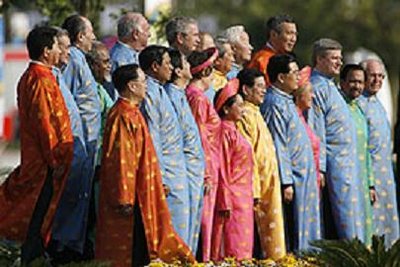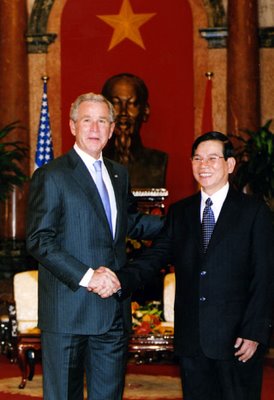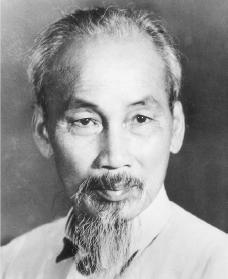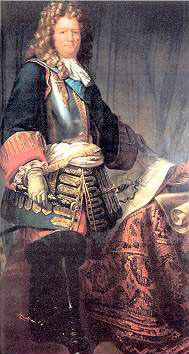
Washington Post
APEC Leaders Speak Out on N. Korea Nukes
By PAUL ALEXANDER
The Associated Press
Sunday, November 19, 2006; 12:31 PM
HANOI, Vietnam -- They would not put it in writing, but the Pacific Rim's often-divergent leaders joined together Sunday to say they worry about North Korea's nuclear weapons program and to urge the reclusive country to resume negotiations.
The verbal statement capped five days of diplomatic discussions in the aftermath of the North's first nuclear test on Oct. 9, which raised concerns about proliferation in the region. But the method of delivery provided a curious culmination to the issue that overshadowed the economic topics that are the core of the 21-member Asia-Pacific Economic Cooperation forum's mission.
Even some of the participants were unsure why the statement was not issued in written form, just orally at the end of the two-day leaders' summit and by Vietnam's president at a news conference after reporters asked him about it.
-------------------------------------------------
 President Bush looks strangely out of place as he shakes hands with Vietnamese President Nguyen Minh Triet. He looks blankly at the camera, with the image of Ho Chi Minh, directly behind him as a reminder that this is a Communist country and that Ho Chi Minh was and still is one of the most revered leaders in this part of the world. We might wonder if Bush has any knowledge of the history of Viet Nam, or if he even cares about it beyond making it just another place to establish a Democracy.
President Bush looks strangely out of place as he shakes hands with Vietnamese President Nguyen Minh Triet. He looks blankly at the camera, with the image of Ho Chi Minh, directly behind him as a reminder that this is a Communist country and that Ho Chi Minh was and still is one of the most revered leaders in this part of the world. We might wonder if Bush has any knowledge of the history of Viet Nam, or if he even cares about it beyond making it just another place to establish a Democracy.Indonesian viewpoint
Indonesian News
Turkish Press
Pacific Rim leaders up ante on Doha Round in Hanoi
San Francisco Chronicle
Bush fails to win pact at Hanoi conference
Pacific Rim nations OK only a mention about North Korea
Michael A. Fletcher, Washington Post
Monday, November 20, 2006
(11-20) 04:00 PST Ho Chi Minh City -- President Bush arrived in this bustling financial center Sunday after achieving mixed results in his attempts to persuade Pacific Rim countries to press North Korea to abandon its nuclear weapons.
The two-day Asia-Pacific Economic Cooperation forum in Hanoi concluded with its members agreeing to a statement urging North Korea to follow through on pledges to dismantle its nuclear weapons program.
Bush had hoped for a more formal, written declaration from APEC members on the issue but was forced to settle for an oral statement, which was read aloud by Vietnamese President Nguyen Minh Triet at the summit's closing session.

HO CHI MINH Biography
Born: May 19, 1890
Nghe An, Vietnam
Died: September 3, 1969
Hanoi, Vietnam
Vietnamese revolutionary and president
He was originally named Nguyễn Sinh Cung and is popularly called Bác Hồ ('Uncle Hồ') in Vietnam. The name Hồ Chí Minh means "he who enlightens." He is most famous for being the founder of the Viet Minh independence movement in 1941 and establishing Communist control in part of Vietnam in the 1950s.
Ho was fluent in English, several dialects of Chinese, French, German and Russian besides his native Vietnamese.

Ho Chi Minh City began as a small fishing village known as Prey Nokor. The area that the city now occupies was originally swampland, and was inhabited by Khmer people for centuries before the arrival of the Vietnamese.
In 1623, King Chey Chettha II of Cambodia (1618-1628) allowed Vietnamese refugees fleeing the Trinh-Nguyen civil war in Vietnam to settle in the area of Prey Nokor, and to set up a custom house at Prey Nokor. Increasing waves of Vietnamese settlers, which the Cambodian kingdom, weakened because of war with Thailand, could not impede, slowly Vietnamized the area. In time, Prey Nokor became known as Saigon.
In 1698, Nguyen Huu Canh, a Vietnamese noble, was sent by the Nguyen rulers of Hu? to establish Vietnamese administrative structures in the area, thus detaching the area from Cambodia, which was not strong enough to intervene. He is often credited with the expansion of Saigon into a significant settlement. A large Vauban citadel called Gia Dinh has been built.
Sébastien Le Prestre, Seigneur de Vauban and later Marquis de Vauban (May 15, 1633 - March 30, 1707), commonly referred to as Vauban, was a Marshal of France and the foremost military engineer of his age, famed for both his skill to design fortifications and to break through them.
The citadel was later destroyed by the French over the Battle of Chi Hoa.
Conquered by France in 1859, the city was influenced by the French during their colonial occupation of Vietnam, and a number of classical western-style buildings in the city reflect this. So much so that Saigon was called "the Pearl of the Far East" (Hòn ng?c Vi?n Ðông) or "Paris in the Orient" (Paris Phuong Ðông).
In 1954, the French were defeated by the Communist Viet Minh in the Battle of Ði?n Biên Ph?, and withdrew from Vietnam. Rather than recognizing the Communists as the new government, they gave their backing to a government established by Emperor B?o Ð?i. B?o Ð?i had set up Saigon as his capital in 1950. At that time Saigon and the city of Cholon (Ch? L?n), which was inhabited primarily by Vietnamese Chinese, were combined into one administrative unit, called the Capital of Saigon (Ðô Thành Sài Gòn in Vietnamese). When Vietnam was officially partitioned into North Vietnam (the Democratic Republic of Vietnam) and South Vietnam (the Republic of Vietnam), the southern government, led by President Ngô Ðình Di?m, retained Saigon as its capital.
At the conclusion of the Vietnam War, on April 30, 1975, the city came under the control of the Vietnam People's Army. In the U.S. this event is commonly called the "Fall of Saigon," while in Vietnam it is called the "Liberation of Saigon."
In 1976, upon the establishment of the unified communist Socialist Republic of Vietnam, the city of Saigon (including Cholon), the province of Gia Ð?nh and 2 suburban districts of two other nearby provinces were combined to create Ho Chí Minh City in honour of the late communist leader Ho Chí Minh.

No comments:
Post a Comment